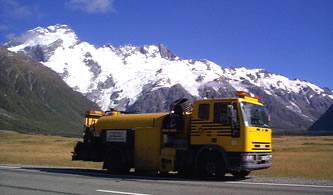Our commitment to ensuring that road users travel safely on our state highways includes tracking the road condition with formal surveys using a vehicle called 'SCRIM+' (Sideway-force Coefficient Routine Investigation Machine).
Using the reliable, timely and accurate data collected by SCRIM+ we're able to respond to road-condition issues promptly and cost effectively.

A SCRIM+ survey vehicle.
Completed between October and March each year, each SCRIM+ survey collects information on:
The survey vehicle also records a 'network video' – what you see as you drive the highway.
Along with responding to immediate condition, we also use the results to:
All data is collected by the SCRIM+ in a single pass, at a survey speed of up to 80 km/h.
Transverse profile bar uses 20 lasers to define the transverse profile over a width of 3.3 metres. The rut depth in each wheelpath is calculated from the transverse profile using a simulated 2 metre straight edge. This data is used to determine the average, maximum and minimum rut depth, the standard deviation and the distribution of rut depths every 20 metres.
The longitudinal profile is measured using two lasers, one in each wheelpath, together with accelerometers fitted on the transverse beam. Vehicle suspension effects are defined by the accelerometers and deducted from the laser output to provide the road profile. The International Roughness Index (IRI) is calculated from the longitudinal profile using the World Bank Quarter Car model, and is reported every 20 metres.
Texture is measured by three 32kHz lasers, one each in the left and right wheelpaths and one between the wheelpaths. Accelerometers remove most of the vehicle motion relative to the road to provide a stable inertial profile from which the MPD (mean profile depth) is calculated. The MPD is measured and calculated according to ISO 13473-1:1997.
The SCRIM+ geometry measurement system uses inclinometers and gyroscopes to sense the vehicle attitude as it travels along the road. Inclinometers measure the forward or back tilt of the vehicle for gradient and the side-to-side tilt of the axles for crossfall. Gyroscopes are used to sense the movement of the SCRIM+ vehicle around corners to calculate the horizontal and vertical curvature. Geometry data is smoothed with a 30 metre moving average and reported at every 10 metres.
The SCRIM+ is fitted with Trimble GPS equipment sampling the Omni-Star satellite to record the differential GPS coordinates of the centreline. Tilt sensors for crossfall and gradient, together with a gyroscope, provide alignment details when out of sight of satellites.
A freely rotating test wheel is applied to the road surface under a known load. A controlled flow of water wets the road surface immediately in front of the wheel, so that when the vehicle moves forward, the test wheel slides in a forward direction on a wet road surface. The force generated by the resistance to sliding indicates the wet skid resistance of the road surface. The results of this testing are averaged to determine the skid resistance of continuous 10 metre sections of the road.